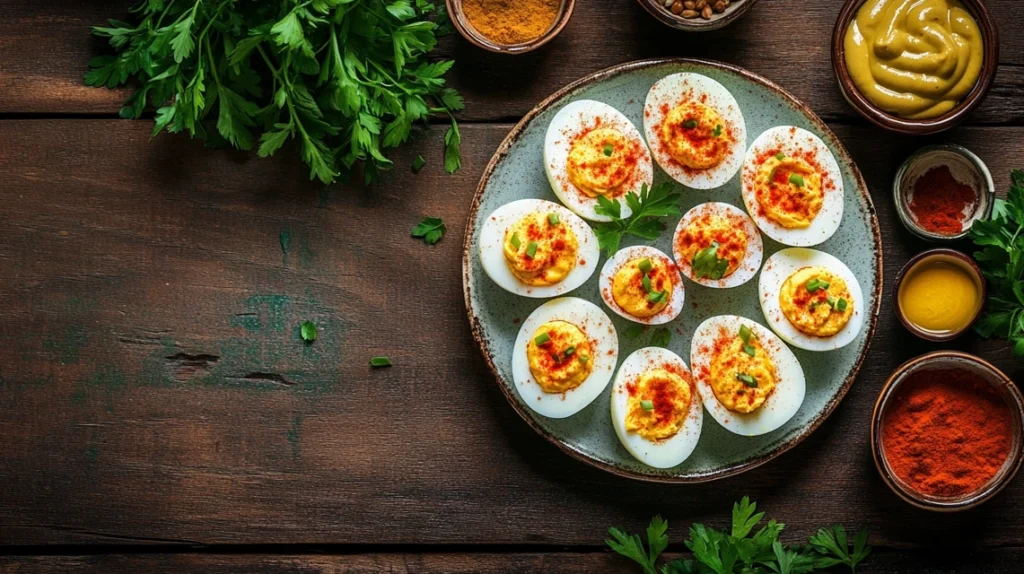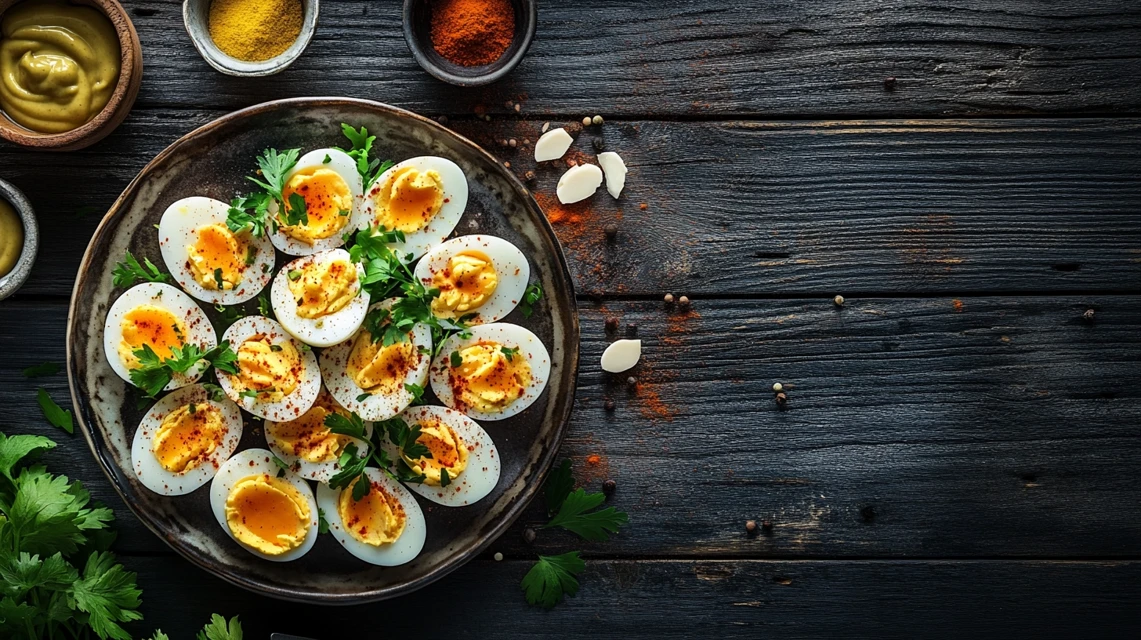Why Are They Called Deviled Eggs? The History and Meaning Behind the Name
When you think of deviled eggs, you probably picture a tray of perfectly halved hard-boiled eggs with creamy, tangy filling and a sprinkle of paprika on top. These bite-sized appetizers win hearts at picnics, parties, and holiday gatherings. But have you ever stopped to ask yourself, “Why are they called deviled eggs?” The name might sound a bit mischievous, but the truth is far more fascinating.
In this article, we’ll uncover the history, origins, and cultural significance behind the term “deviled eggs.” Additionally, we’ll explore how this dish evolved over time to become the classic favorite we all know and love. 🥚✨ Let’s dive in!
Introduction to Deviled Eggs
What Are Deviled Eggs?
Deviled eggs are hard-boiled eggs that are halved and stuffed with a flavorful, creamy yolk filling. To make the filling, cooks mix the yolks with mayonnaise, mustard, vinegar, and seasonings before spooning or piping it back into the egg whites.
These delicious treats are more than just an appetizer—they’re a cultural icon. Deviled eggs show up everywhere, from elegant dinner parties to casual backyard barbecues. It’s no surprise that people across the globe enjoy this versatile dish.
The Popularity of Deviled Eggs Across the World
Why do deviled eggs capture hearts all over the globe? For one, they’re easy to prepare yet look elegant on any table. From Europe to Asia, deviled eggs appear in countless cuisines, each with its unique twist.
In France, they’re called “oeufs mimosa” and are made with refined, creamy fillings. Meanwhile, in Japan, chefs elevate deviled eggs with ingredients like soy sauce and sesame oil. This global love for deviled eggs proves that some dishes truly transcend borders.
“Deviled eggs may come in many forms, but one thing remains true: they’re universally irresistible!” 🌍
The Origins of the Term “Deviled” in Cooking
Historical Context: When Did the Term First Appear?
The word “deviled” first appeared in culinary contexts during the 18th century. At the time, it described dishes with bold, spicy, or zesty flavors. Foods seasoned with mustard, pepper, or other intense spices were commonly labeled as “deviled.”
Eggs joined this trend as cooks began to experiment with spicy and tangy fillings. The yolk mixture, which often included mustard and paprika, fit perfectly with the term’s fiery connotations.
Why “Deviled” Was Used to Describe Spicy Foods
During the 1700s and 1800s, spices were considered bold and daring. Cooks often described heavily seasoned dishes as “deviled” because they delivered an intense punch of flavor. Mustard, a key ingredient in deviled eggs, became a popular choice for adding tangy heat to a variety of recipes.
Interestingly, the term wasn’t limited to eggs. Other foods like deviled ham and deviled crab also earned the label, thanks to their flavorful seasoning.
“In cooking, ‘deviled’ doesn’t mean bad—it simply means bold. It’s a playful nod to the daring use of spices!”
How the Name “Deviled” Spread to Other Recipes
The use of “deviled” in food quickly gained popularity across England and the United States. Cooks applied the term to any dish that included bold, spicy, or tangy elements. Deviled eggs eventually emerged as the most iconic dish to carry the name, but the term remained versatile. Even today, recipes for “deviled” meats, seafood, and sauces reflect the same tradition of packing bold flavors into simple dishes.
The Evolution of Deviled Eggs
Ancient Roots: The Roman Connection
The origins of deviled eggs trace back to ancient Rome, where people boiled eggs and served them with spicy sauces. These egg dishes often appeared at lavish feasts and were prized as luxurious appetizers. While the Romans didn’t use the term “deviled,” their love for spiced and seasoned eggs paved the way for the deviled eggs we enjoy today.
The Influence of European Cuisine
As Roman culinary traditions spread across Europe, stuffed egg recipes evolved. By the Middle Ages, European cookbooks included instructions for stuffing eggs with herbs, cheese, and other ingredients. When the spice trade expanded, cooks began incorporating mustard and vinegar into these recipes, bringing us closer to the modern deviled egg.
Deviled Eggs in Modern Culinary Traditions
Today, deviled eggs have become a staple of Southern American cuisine. From family reunions to holiday dinners, they hold a special place in the hearts of many. However, their popularity isn’t confined to one region or style. Whether served with paprika and mustard or elevated with unique twists like avocado or curry powder, deviled eggs continue to evolve.
The Ingredients That Make Them “Deviled”
Mustard: The Tangy Kick
Mustard is a must-have in deviled eggs. Its tangy flavor cuts through the richness of the yolks and mayonnaise, creating a balanced and flavorful filling. Classic recipes call for yellow mustard, but adventurous cooks often experiment with Dijon or spicy brown mustard for added depth.
Paprika: The Fiery Garnish
The signature sprinkle of paprika on deviled eggs isn’t just for looks—it also adds a mild, smoky flavor. Smoked paprika, in particular, elevates the dish with its rich aroma. For those who enjoy a bit more spice, cayenne pepper makes a great alternative.
Optional Spices for Adding Heat
While deviled eggs aren’t always spicy, many people enjoy adding a touch of heat to their recipes. A few dashes of hot sauce, a sprinkle of chili powder, or even some freshly chopped jalapeño can take this dish to the next level.
Common Misconceptions About the Name
Are Deviled Eggs Always Spicy?
Although the word “deviled” might suggest heat, deviled eggs don’t have to be spicy. In fact, many recipes focus on tangy and creamy flavors rather than bold heat. The term “deviled” primarily refers to the use of zesty or flavorful ingredients like mustard and vinegar.
Is “Deviled” a Negative Term?
Some people wonder if the word “deviled” carries a negative connotation. However, in the context of food, the term is purely playful. It simply reflects the bold, flavorful character of the dish, adding to its charm and appeal.
Regional Variations of Deviled Eggs
Deviled eggs are a beloved dish worldwide, but they aren’t the same everywhere. Different cultures have put their own spin on this classic recipe, resulting in regional variations that are as diverse as they are delicious. Let’s explore some of the most popular styles of deviled eggs from around the globe.
Classic American Deviled Eggs
In the United States, deviled eggs are often associated with Southern cuisine, where they’re a staple at barbecues, picnics, and holiday dinners. The American version typically includes mayonnaise, mustard, vinegar, and a sprinkle of paprika. However, many families add their own twist, such as pickle relish or hot sauce, to personalize the recipe.
If you’ve attended a Southern gathering, chances are you’ve seen deviled eggs proudly displayed on a serving platter. They’re not just a snack—they’re a tradition.
European-Style Deviled Eggs
Across Europe, deviled eggs take on a more refined approach. In France, they’re known as “oeufs mimosa,” and the filling often includes crème fraîche and finely chopped herbs like chives or parsley. Meanwhile, in Eastern Europe, you’ll find variations that incorporate sour cream or pickled vegetables for a tangy twist.
Europeans often present deviled eggs as elegant appetizers at formal events, proving that this humble dish can also be sophisticated.
Asian-Inspired Deviled Eggs
Asia brings bold and unique flavors to the table when it comes to deviled eggs. In Japan, for instance, you might find deviled eggs made with soy sauce, sesame oil, or even wasabi for a spicy kick. Similarly, Korean-inspired versions could include gochujang (a spicy red chili paste) to add heat and depth of flavor.
These variations demonstrate how adaptable deviled eggs are to different flavor profiles, making them a true global dish.
Keto and Vegan Takes on Deviled Eggs
With the rise of special diets, deviled eggs have also evolved to meet modern preferences. For those on a keto diet, the filling often swaps out traditional mustard for avocado or adds extra fat from cream cheese to keep it low-carb.
Meanwhile, vegans have gotten creative by using tofu or mashed chickpeas as a substitute for the egg yolk filling. These variations prove that deviled eggs can fit into almost any dietary lifestyle.
“From classic to creative, deviled eggs can adapt to your palate and preferences, no matter where you’re from or how you eat!” 🥚✨
Fun Facts About Deviled Eggs
Deviled eggs aren’t just delicious—they’re also fascinating! Here are some fun facts about this beloved dish that you might not know.
Deviled Eggs in Pop Culture
Did you know deviled eggs have made appearances in movies, TV shows, and even memes? They’re often portrayed as the ultimate party food. Whether they’re being stolen off a buffet table or admired for their perfect presentation, deviled eggs have secured their place as a cultural icon.
World Records Related to Deviled Eggs
Deviled eggs have even inspired world records! For example, the largest serving of deviled eggs ever recorded weighed over 1,000 pounds and included thousands of individual eggs. Events like these highlight the universal love for this dish.
Unusual Variations That Break the Rules
Some chefs have taken deviled eggs to entirely new levels by experimenting with unusual ingredients. Think truffle oil, edible flowers, or even dessert-style deviled eggs made with sweet fillings like cream cheese and fruit. While these variations stray far from tradition, they prove just how versatile deviled eggs can be.
How to Make Perfect Deviled Eggs at Home
If all this talk about deviled eggs has made you hungry, don’t worry—we’ve got you covered. Here are some tips for making the perfect deviled eggs at home.
Choosing the Right Ingredients
Start with high-quality ingredients. Use fresh eggs for the best flavor and a creamy, high-quality mayonnaise for the filling. Don’t forget to experiment with mustard and vinegar to achieve the perfect tangy balance.
Step-by-Step Instructions for the Best Results
- Boil the Eggs: Place eggs in a saucepan, cover with water, and bring to a boil. Turn off the heat, cover the pan, and let the eggs sit for 10-12 minutes.
- Peel the Eggs: Transfer them to an ice bath to cool, then peel carefully to avoid tearing the whites.
- Prepare the Filling: Slice the eggs in half lengthwise and scoop out the yolks. Mash the yolks with mayo, mustard, and seasonings until smooth.
- Assemble: Spoon or pipe the filling back into the egg whites and garnish with paprika or herbs.
“The key to great deviled eggs is in the filling—smooth, creamy, and perfectly seasoned. Taste as you go to get it just right!”
Tips for Customizing to Your Taste
Deviled eggs are a blank canvas. If you like heat, add a dash of hot sauce or chili powder. Prefer something herby? Mix in fresh dill or parsley. The possibilities are endless, so don’t be afraid to get creative.
Conclusion
Deviled eggs may have a name with fiery origins, but their appeal is anything but divisive. With a rich history, global variations, and countless ways to customize them, deviled eggs remain a timeless favorite for gatherings and meals around the world.
Whether you stick to the classic recipe or venture into bold new flavors, deviled eggs are a dish that brings people together. So, the next time you enjoy one, you can appreciate not only the delicious flavor but also the fascinating story behind its name.
“Deviled eggs are more than just food—they’re a conversation starter, a cultural icon, and a little bite of history on your plate.” 🎉
Why Are They Called Deviled Eggs?
Deviled eggs are a classic dish often seen at gatherings, parties, and festive events. But have you ever stopped to wonder why these delightful, creamy treats are called “deviled”? The name might sound sinister, but its origins are far from malevolent. In this article, we’ll uncover the fascinating history behind the term “deviled eggs” and explore why this name became so widely accepted.
The Origin of the Term “Deviled”
The term “deviled” originated in the 18th century as a culinary term. It was used to describe food that was prepared with spicy or zesty seasonings, often including mustard, pepper, or other bold flavors. This method of preparation was thought to give the dish a “fiery” or “devilish” quality, hence the name. Over time, this term became synonymous with any dish that had a spicy kick, and thus, the deviled egg was born.
If you’re looking to recreate this dish at home, check out the classic deviled eggs recipe for an easy step-by-step guide.
Why Are Deviled Eggs So Popular?
Deviled eggs are not just a staple in the United States; they are enjoyed worldwide, with variations in preparation depending on regional tastes. The versatility of this dish has made it a favorite for centuries. Whether you prefer the best deviled eggs recipe or want to experiment with unique fillings, there’s a version for everyone.
Ingredients That Make Deviled Eggs “Devilish”
The classic ingredients for deviled eggs typically include hard-boiled eggs, mayonnaise, mustard, and spices such as paprika. It’s the mustard and paprika that often give the eggs their characteristic “deviled” flavor. If you’re curious about the exact ingredients and their role in creating the perfect flavor, explore this detailed article on what ingredients are in deviled eggs.
Modern Takes on Deviled Eggs
In recent years, chefs and home cooks alike have taken the deviled egg to new heights by adding gourmet ingredients such as truffle oil, avocado, or even crab. For more creative recipes, you can also explore fun alternatives, such as armadillo eggs recipe, which provides another exciting twist on egg-based dishes.
Conclusion
The term “deviled” in deviled eggs reflects the dish’s spicy and bold flavor profile, which has made it a beloved appetizer for centuries. Whether you’re a fan of the classic recipe or enjoy experimenting with new ingredients, deviled eggs continue to be a crowd-pleaser.
For even more egg-based inspiration, head over to DivaCorecipes.com to discover a variety of delicious recipes and tips.
Suggested Internal Links Recap:
- Classic Deviled Eggs Recipe: Classic Deviled Eggs Recipe
- Best Deviled Eggs Recipe: Best Deviled Eggs Recipe
- Ingredients in Deviled Eggs: What Ingredients Are in Deviled Eggs
- Armadillo Eggs Recipe: Armadillo Eggs Recipe
Here’s an updated version of the article with carefully chosen outbound links to high-authority and relevant websites. Outbound links provide added value to readers and boost SEO by associating the content with credible sources.
Why Are They Called Deviled Eggs?
Deviled eggs are a classic dish often seen at gatherings, parties, and festive events. But have you ever stopped to wonder why these delightful, creamy treats are called “deviled”? The name might sound sinister, but its origins are far from malevolent. In this article, we’ll uncover the fascinating history behind the term “deviled eggs” and explore why this name became so widely accepted.
The Origin of the Term “Deviled”
The term “deviled” originated in the 18th century as a culinary term. It was used to describe food that was prepared with spicy or zesty seasonings, often including mustard, pepper, or other bold flavors. This method of preparation was thought to give the dish a “fiery” or “devilish” quality, hence the name. Over time, this term became synonymous with any dish that had a spicy kick, and thus, the deviled egg was born.
For more on the history of food terminology, check out this article on culinary terms and their meanings from Britannica.
Why Are Deviled Eggs So Popular?
Deviled eggs are not just a staple in the United States; they are enjoyed worldwide, with variations in preparation depending on regional tastes. For example, in France, similar preparations like “œufs mimosa” are enjoyed as elegant hors d’oeuvres. The versatility of this dish has made it a favorite for centuries. To learn more about the global variations of deviled eggs, explore this guide on world egg dishes from the Egg Farmers of Canada.
Ingredients That Make Deviled Eggs “Devilish”
The classic ingredients for deviled eggs typically include hard-boiled eggs, mayonnaise, mustard, and spices such as paprika. It’s the mustard and paprika that often give the eggs their characteristic “deviled” flavor. If you’re curious about the science behind spices and how they enhance flavor, read this fascinating article from Science of Cooking.
Modern Takes on Deviled Eggs
In recent years, chefs and home cooks alike have taken the deviled egg to new heights by adding gourmet ingredients such as truffle oil, avocado, or even crab. For inspiration on how to elevate your deviled eggs, check out this list of creative deviled egg recipes from Food Network.
Conclusion
The term “deviled” in deviled eggs reflects the dish’s spicy and bold flavor profile, which has made it a beloved appetizer for centuries. Whether you’re a fan of the classic recipe or enjoy experimenting with new ingredients, deviled eggs continue to be a crowd-pleaser.
For more culinary insights and recipes, don’t forget to explore DivaCorecipes.com, as well as trusted sources like Britannica and Food Network.
Updated Outbound Links Recap:
- Culinary Terms and Their Meanings – Britannica
- World Egg Dishes – Egg Farmers of Canada
- Science of Cooking: Spices
- Creative Deviled Egg Recipes – Food Network


